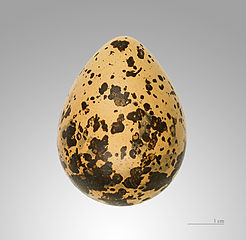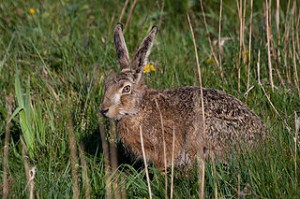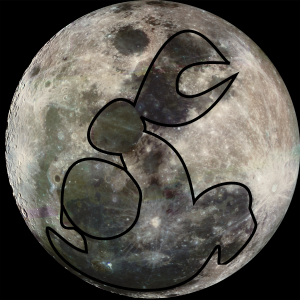
From one half the egg, the lower,Grows the nether vault of Terra:From the upper half remaining,Grows the upper vault of Heaven;From the white part come the moonbeams,From the yellow part the sunshine,From the motley part the starlight,From the dark part grows the cloudage;And the days speed onward swiftly….
Spurred by the lengthening days at the spring equinox, birds begin to lay their eggs, and egg gathering forms the basis for many spring rites. The custom of dying and decorating chicken eggs probably began as a way of mimicking the many colors and designs of wild bird eggs that were once gathered in the spring hunts.In the Netherlands to this day there are spring hunts for the eggs of the wild Lapwing, who makes her nest on the ground. Bird nests probably formed the inspiration for basket weaving, and perhaps before this innovation people gathered their eggs in nests.Another animal who nests in the tall grass in the early spring is the European Brown Hare, who makes a rudimentary nest or “form” for each of her babies. This is where we get the idea that the “Easter Bunny” is hiding eggs. The hare is also linked with the moon, itself shaped like an egg, because the outline of a hare holding an egg can be seen on the moon’s surface.
Eosturmonath has a name which is now translated “Paschal month” and which was once called after a goddess of theirs named Eostre, in whose honour feasts were celebrated in that month. Now they designate that Paschal season by her name, calling the joys of the new rite by the time-honoured name of the old observance.
So we have a spring folk custom of a bunny who hides eggs or treats, baskets lined with goodies and fake grass, and organized hunts for colorful eggs, all associated with an old Germanic (Anglo-Saxon) holiday. Moreover, spring hare folklore can be traced to Germany and egg hunts to the (Germanic) Netherlands, among other places. It certainly looks like a traditional Pagan holiday, barring direct evidence to disabuse us of this assumption. Surprisingly, there are many Christians, historians, and even Pagans who have taken on the mission of disabusing us of the notion of Easter as a Pagan holiday.Part of this hinges on the fact that Bede does not mention hares or eggs in connection with Easter. These can therefore be assumed, if desired, to be of recent origin. It always makes sense to our detractors to assume recent origin for customs embraced by modern Pagans, even in the face of contradictory evidence. The bar for acceptability of evidence can be made extremely high, or, failing that, evidence can be simply ignored with ignorance forming the justification for saying “no evidence exists.”
Hosking, Rebecca. “The Lapwing – the unsung hero of Easter and farmland icon” Permaculture Inspiration for Sustainable Living, April, 2011. Hunt-Anschütz, A.E. Eostre and Easter Customs. Association of Polytheist Traditions, 2006. Note: I got my quote from Bede from this article. In some ways this article illustrates the type of poor Pagan scholarship I’m talking about. For example, pre-Christian hare associations are legion, and others have traced the introduction of hares into Christianity from Celtic pagan practices (see Hare by Simon Carnell). Do an exhuastive study before stating “there is no reason to believe.” Also, stating “the symbolism surrounding” an item “fits into” Christianity begs the question. Find out how and why something without Biblical associations was “fitted into” Christian practices. In fairness, the author does concede that it’s implausible to say St. Bede was making up goddesses.
Hunt-Anschütz, A.E. Eostre and Easter Customs. Association of Polytheist Traditions, 2006. Note: I got my quote from Bede from this article. In some ways this article illustrates the type of poor Pagan scholarship I’m talking about. For example, pre-Christian hare associations are legion, and others have traced the introduction of hares into Christianity from Celtic pagan practices (see Hare by Simon Carnell). Do an exhuastive study before stating “there is no reason to believe.” Also, stating “the symbolism surrounding” an item “fits into” Christianity begs the question. Find out how and why something without Biblical associations was “fitted into” Christian practices. In fairness, the author does concede that it’s implausible to say St. Bede was making up goddesses.
